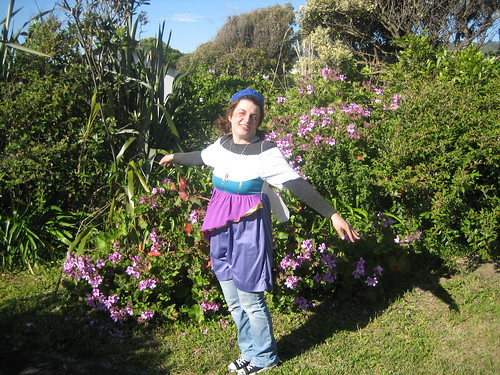Not this year.
Halloween used to be my favourite holiday. Over the years, I've stubbornly persisted in celebrating it. In ninth grade, I was the only one who wore a Halloween costume to school. When I moved to San Francisco, their Halloween was my mecca, and made my obsession with witches and haunted houses look tame (if not quite normal for an adult).

Halloween parade in San Francisco
But since moving to New Zealand, a country with no reason to celebrate Halloween, I've been going through the motions. I mean, despite my best efforts.I had already given up Thanksgiving and July Fourth. But I tried to keep Halloween in my heart. I did my best. Halloween was like my Christmas. Or my Rocky Horror Picture Show. Because Halloween is the ultimate day for theatre geeks, creative types, and what polite people call eccentrics.
However (as you know), in New Zealand, Halloween happens in the spring. The days are getting longer. The idea of Halloween (the spirit of it, if you will) is completely counter to the season that it is actually in. There are no spooky bare trees or other metaphors for death. The earth is teeming with life. There are baby birds, baby lambs, and green grass.
And against this spring tableau, imagine two dozen children (tops) who are possibly wearing costumes hastily purchased an hour ago at the $2 Shop. They are wandering around in broad daylight, among wildly blooming geraniums, hoping to find the odd couple of families in the village who are participating in that “American holiday”.
Last year, I decided to turn Halloween on its head, and make our garden into a fairy grotto. I thought it would make more sense to have an Easter-ish approach to a Southern Hemisphere Halloween. Needless to say, this idea was a flop.
“What are you, a beer wench?” asked Adam.

“I am a scary fairy,” I said, with my teeth clenched.
Celebrating Halloween feels slightly (or to be honest, completely) ridiculous. I always imagine Adam and I will have a big “fancy dress” party at Halloween. We will turn our house into a haunted castle, and make the kids carve pumpkins (which are not in season), and dip their hands into cold spaghetti. There will be a bonfire in the back garden. Our party will be like the Peanuts.
 Adam is lukewarm about my Halloween ideas. “I think my sister is planning a lunch on Sunday, October 31st,” he said.
Adam is lukewarm about my Halloween ideas. “I think my sister is planning a lunch on Sunday, October 31st,” he said.Who has a family “do” on Halloween? Yes, that’s right. People who don’t celebrate Halloween.
So, I give up. I’m not going to force Halloween on people any more. On Halloween, we will close our curtains. We will pretend we aren’t home. (Just like all the other Kiwis.)

